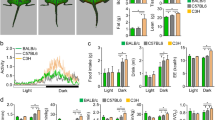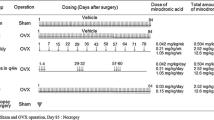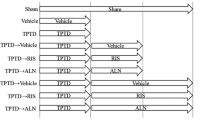Abstract
The lack of estrogen and inactivity are both important in the pathogenesis of osteoporosis in elderly women, and there have been no appropriate rodent studies to examine the effects of common bisphosphonates on these two components separately. We compared the efficacy of alendronate (ALN) on the long bones of aged female rats, which were sedentary, estrogen deficient, or both. The rats were either forced to remain in a sitting position or allowed to walk in standard cages with or without ALN administration. The 8-week experimental period began 5 weeks after ovariectomy or sham surgery. Parameters of the hindlimb bones were determined by a three-point bending test, peripheral quantitative computed tomography, microfocus computed tomography, confocal laser Raman microspectroscopy, and dynamic histomorphometry. Regardless of ovariectomy, ALN was ineffective against the deterioration of breaking stress caused by sitting even though the trabecular bone mineral density was significantly higher in the sitting–ALN groups. Toughness was significantly deficient in the ovariectomy sitting–ALN group. This was in agreement with the bone geometry with a greater marrow space. Sitting also increased the mineral-to-matrix ratio and the carbonate-to-phosphate ratio, both indicative of aged bone. A greater loss of proteinaceous amide intensity compared with mineral intensity resulted in an increased mineral-to-matrix ratio in the presence of ALN. Sitting resulted in deficits in the quality and the geometry of cortical bone, resulting in fragility. The use of bisphosphonates, such as ALN, may provide a therapy best suited for osteoporotic individuals whose daily activity is not limited.







Similar content being viewed by others
References
Albrand G, Munoz F, Sornay-Rendu E, DuBoeuf F, Delmas PD (2003) Independent predictors of all osteoporosis-related fractures in healthy postmenopausal women: the OFELY study. Bone 32:78–85
Dalsky GP, Stocke KS, Ehsani AA, Slatopolsky E, Lee WC, Birge SJ Jr (1988) Weight-bearing exercise training and lumbar bone mineral content in postmenopausal women. Ann Intern Med 108:824–828
Morey ER, Baylink DJ (1978) Inhibition of bone formation during space flight. Science 201:1138–1141
Weinreb M, Rodan GA, Thompson DD (1989) Osteopenia in the immobilized rat hind limb is associated with increased bone resorption and decreased bone formation. Bone 10:187–194
Bagi CM, Mecham M, Weiss J, Miller SC (1993) Comparative morphometric changes in rat cortical bone following ovariectomy and/or immobilization. Bone 14:877–883
LeBlanc AD, Driscol TB, Shackelford LC, Evans HJ, Rianon NJ, Smith SM, Feeback DL, Lai D (2002) Alendronate as an effective countermeasure to disuse induced bone loss. J Musculoskelet Neuronal Interact 2:335–343
Thompson DD, Seedor JG, Weinreb M, Rosini S, Rodan GA (1990) Aminohydroxybutane bisphosphonate inhibits bone loss due to immobilization in rats. J Bone Miner Res 5:279–286
Apseloff G, Girten B, Weisbrode SE, Walker M, Stern LS, Krecic ME, Gerber N (1993) Effects of aminohydroxybutane bisphosphonate on bone growth when administered after hind-limb bone loss in tail-suspended rats. J Pharmacol Exp Ther 267:515–521
Li CY, Price C, Delisser K, Nasser P, Laudier D, Clement M, Jepsen KJ, Schaffler MB (2005) Long-term disuse osteoporosis seems less sensitive to bisphosphonate treatment than other osteoporosis. J Bone Miner Res 20:117–124
Boyce WJ, Vessey MP (1988) Habitual physical inertia and other factors in relation to risk of fracture of the proximal femur. Age Ageing 17:319–327
Wickham CA, Walsh K, Cooper C, Barker DJ, Margetts BM, Morris J, Bruce SA (1989) Dietary calcium, physical activity, and risk of hip fracture: a prospective study. BMJ 299:889–892
Feskanich D, Willett W, Colditz G (2002) Walking and leisure-time activity and risk of hip fracture in postmenopausal women. JAMA 288:2300–2306
Binkley N, Krueger D, Buehring B (2013) What’s in a name revisited: should osteoporosis and sarcopenia be considered components of “dysmobility syndrome?”. Osteoporos Int 24:2955–2959
Miyagawa K, Kozai Y, Ito Y, Furuhama T, Naruse K, Nonaka K, Nagai Y, Yamato H, Kashima I, Ohya K, Aoki K, Mikuni-Takagaki Y (2011) A novel underuse model shows that inactivity but not ovariectomy determines the deteriorated material properties and geometry of cortical bone in the tibia of adult rats. J Bone Miner Metab 29:422–436
Morris MD, Finney WF, Rajachar RM, Kohn DH (2004) Bone tissue ultrastructural response to elastic deformation probed by Raman spectroscopy. Faraday Discuss 126:159–168
Tarnowski CP, Ignelzi MA Jr, Morris MD (2002) Mineralization of developing mouse calvaria as revealed by Raman microspectroscopy. J Bone Miner Res 17:1118–1126
Iwasaki Y, Kazama JJ, Yamato H, Fukagawa M (2011) Changes in chemical composition of cortical bone associated with bone fragility in rat model with chronic kidney disease. Bone 48:1260–1267
Rittweger J, Frost HM, Schiessl H, Ohshima H, Alkner B, Tesch P, Felsenberg D (2005) Muscle atrophy and bone loss after 90 days’ bed rest and the effects of flywheel resistive exercise and pamidronate: results from the LTBR study. Bone 36:1019–1029
Bagi CM, Hanson N, Andresen C, Pero R, Lariviere R, Turner CH, Laib A (2006) The use of micro-CT to evaluate cortical bone geometry and strength in nude rats: correlation with mechanical testing, pQCT and DXA. Bone 38:136–144
Jee WS, Yao W (2001) Overview: animal models of osteopenia and osteoporosis. J Musculoskelet Neuronal Interact 1:193–207
Allen MR, Reinwald S, Burr DB (2008) Alendronate reduces bone toughness of ribs without significantly increasing microdamage accumulation in dogs following 3 years of daily treatment. Calcif Tissue Int 82:354–360
Nyman JS, Roy A, Tyler JH, Acuna RL, Gayle HJ, Wang X (2007) Age-related factors affecting the postyield energy dissipation of human cortical bone. J Orthop Res 25:646–655
Huang TH, Chang FL, Lin SC, Liu SH, Hsieh SS, Yang RS (2008) Endurance treadmill running training benefits the biomaterial quality of bone in growing male Wistar rats. J Bone Miner Metab 26:350–357
Macias BR, Swift JM, Nilsson MI, Hogan HA, Bouse SD, Bloomfield SA (2012) Simulated resistance training, but not alendronate, increases cortical bone formation and suppresses sclerostin during disuse. J Appl Physiol (1985) 112:918–925
Swift JM, Swift SN, Nilsson MI, Hogan HA, Bouse SD, Bloomfield SA (2011) Cancellous bone formation response to simulated resistance training during disuse is blunted by concurrent alendronate treatment. J Bone Miner Res 26:2140–2150
Erben RG (1996) Trabecular and endocortical bone surfaces in the rat: modeling or remodeling? Anat Rec 246:39–46
Kobayashi S, Takahashi HE, Ito A, Saito N, Nawata M, Horiuchi H, Ohta H, Ito A, Iorio R, Yamamoto N, Takaoka K (2003) Trabecular minimodeling in human iliac bone. Bone 32:163–169
Ubara Y, Tagami T, Nakanishi S, Sawa N, Hoshino J, Suwabe T, Katori H, Takemoto F, Hara S, Takaichi K (2005) Significance of minimodeling in dialysis patients with adynamic bone disease. Kidney Int 68:833–839
Kamiya N, Ye L, Kobayashi T, Lucas DJ, Mochida Y, Yamauchi M, Kronenberg HM, Feng JQ, Mishina Y (2008) Disruption of BMP signaling in osteoblasts through type IA receptor (BMPRIA) increases bone mass. J Bone Miner Res 23:2007–2017
Zebaze RM, Ghasem-Zadeh A, Bohte A, Iuliano-Burns S, Mirams M, Price RI, Mackie EJ, Seeman E (2010) Intracortical remodelling and porosity in the distal radius and post-mortem femurs of women: a cross-sectional study. Lancet 375:1729–1736
Burghardt AJ, Kazakia GJ, Ramachandran S, Link TM, Majumdar S (2010) Age- and gender-related differences in the geometric properties and biomechanical significance of intracortical porosity in the distal radius and tibia. J Bone Miner Res 25:983–993
Zebaze R, Seeman E (2015) Cortical bone: a challenging geography. J Bone Miner Res 30:24–29
Akkus O, Adar F, Schaffler MB (2004) Age-related changes in physicochemical properties of mineral crystals are related to impaired mechanical function of cortical bone. Bone 34:443–453
Burket J, Gourion-Arsiquaud S, Havill LM, Baker SP, Boskey AL, van der Meulen MC (2011) Microstructure and nanomechanical properties in osteons relate to tissue and animal age. J Biomech 44:277–284
Gourion-Arsiquaud S, Allen MR, Burr DB, Vashishth D, Tang SY, Boskey AL (2010) Bisphosphonate treatment modifies canine bone mineral and matrix properties and their heterogeneity. Bone 46:666–672
Augat P, Schorlemmer S (2006) The role of cortical bone and its microstructure in bone strength. Age Ageing 35(Suppl 2):ii27–ii31
Gourion-Arsiquaud S, Boskey AL (2007) Fourier transform infrared and Raman microspectroscopy and microscopic imaging of bone. Curr Opin Orthop 18:499–504
Pelletier MJ (2003) Quantitative analysis using Raman spectrometry. Appl Spectrosc 57:20A–42A
Fuchs RK, Faillace ME, Allen MR, Phipps RJ, Miller LM, Burr DB (2011) Bisphosphonates do not alter the rate of secondary mineralization. Bone 49:701–705
Gamsjaeger S, Buchinger B, Zwettler E, Recker R, Black D, Gasser JA, Eriksen EF, Klaushofer K, Paschalis EP (2011) Bone material properties in actively bone-forming trabeculae in postmenopausal women with osteoporosis after three years of treatment with once-yearly Zoledronic acid. J Bone Miner Res 26:12–18
Cummings SR, Nevitt MC, Browner WS, Stone K, Fox KM, Ensrud KE, Cauley J, Black D, Vogt TM (1995) Risk factors for hip fracture in white women. Study of Osteoporotic Fractures Research Group. N Engl J Med 332:767–773
Sato Y, Iwamoto J, Kanoko T, Satoh K (2005) Risedronate therapy for prevention of hip fracture after stroke in elderly women. Neurology 64:811–816
Poole KE, Loveridge N, Rose CM, Warburton EA, Reeve J (2007) A single infusion of zoledronate prevents bone loss after stroke. Stroke 38:1519–1525
Sato Y, Oizumi K, Kuno H, Kaji M (1999) Effect of immobilization upon renal synthesis of 1,25-dihydroxyvitamin D in disabled elderly stroke patients. Bone 24:271–275
Fuchs RK, Shea M, Durski SL, Winters-Stone KM, Widrick J, Snow CM (2007) Individual and combined effects of exercise and alendronate on bone mass and strength in ovariectomized rats. Bone 41:290–296
Yamane H, Sakai A, Mori T, Tanaka S, Moridera K, Nakamura T (2009) The anabolic action of intermittent PTH in combination with cathepsin K inhibitor or alendronate differs depending on the remodeling status in bone in ovariectomized mice. Bone 44:1055–1062
Matsumoto Y, Mikuni-Takagaki Y, Kozai Y, Miyagawa K, Naruse K, Wakao H, Kawamata R, Kashima I, Sakurai T (2009) Prior treatment with vitamin K(2) significantly improves the efficacy of risedronate. Osteoporos Int 20:1863–1872
Acknowledgments
C. Shimada and H. Kawabata provided indispensable technical assistance. This study was supported by Japan Society for the Promotion of Science Grants-in-Aid for Scientific Research to K.N., M.I., and Y.M.T.
Author information
Authors and Affiliations
Corresponding author
Ethics declarations
Conflict of interest
The authors declare that they have no conflict of interest.
Additional information
K. Naurse and K. Uchida contributed equally to this work.
Electronic supplementary material
Below is the link to the electronic supplementary material.
About this article
Cite this article
Naruse, K., Uchida, K., Suto, M. et al. Alendronate does not prevent long bone fragility in an inactive rat model. J Bone Miner Metab 34, 615–626 (2016). https://doi.org/10.1007/s00774-015-0714-y
Received:
Accepted:
Published:
Issue Date:
DOI: https://doi.org/10.1007/s00774-015-0714-y




